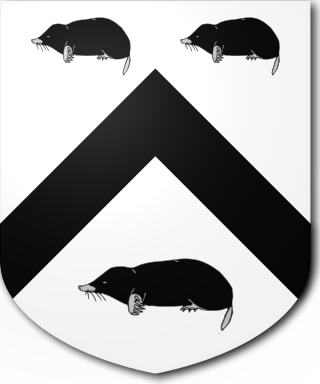
Baron Hesketh, of Hesketh in the County Palatine of Lancaster, is a title in the Peerage of the United Kingdom. It was created in 1935 for Sir Thomas Fermor-Hesketh, 8th Baronet, who had previously briefly represented Enfield in the House of Commons as a Conservative. As of 2010 the titles are held by his grandson, the third Baron, who succeeded his father in 1955. Lord Hesketh held junior ministerial positions in the Conservative administrations of Margaret Thatcher and John Major. However, he lost his seat in the House of Lords after the House of Lords Act 1999 removed the automatic right of hereditary peers to sit in the upper chamber of Parliament.

Earl of Pomfret was a title in the Peerage of Great Britain created in 1721 for Thomas Fermor, 2nd Baron Leominster. The title became extinct upon the death of the fifth earl in 1867.

Sir Edward Montagu of Boughton, Hanging Houghton and Hemington in Northamptonshire was an English lawyer and judge in the time of Henry VIII and Edward VI. He was Chief Justice of the King's Bench from 1539 to 1545 and Chief Justice of the Common Pleas from 1545 to 1553.

Nicholas Vaux, 1st Baron Vaux of Harrowden was a soldier and courtier in England and an early member of the House of Commons. He was the son of Lancastrian loyalists Sir William Vaux of Harrowden and Katherine Penyson, a lady of the household of Queen Margaret of Anjou, wife of the Lancastrian king, Henry VI of England. Katherine was a daughter of Gregorio Panizzone of Courticelle, in Piedmont, Italy which was at that time subject to King René of Anjou, father of Queen Margaret of Anjou, as ruler of Provence. He grew up during the years of Yorkist rule and later served under the founder of the Tudor dynasty, Henry VII.

Philip Stanhope, 1st Earl of Chesterfield was an English nobleman, aristocrat and royalist, who was created the first Earl of Chesterfield by King Charles I in 1628.

Frederick Keppel was a Church of England clergyman, Bishop of Exeter.

Peregrine Hyde Osborne, 3rd Duke of Leeds was a British peer.

Sir John St John, 1st Baronet of Lydiard Tregoze in the English county of Wiltshire, was a Member of Parliament and prominent Royalist during the English Civil War. He was created a baronet on 22 May 1611.
Margaret Dymoke was a lady-in-waiting at the court of Henry VIII of England. Her married names were Vernon, Coffin and Manners. She was born around 1500 in Scrivelsby, Lincolnshire, the daughter of Sir Robert Dymoke of Scrivelsby and Jane Cressner. Her first husband was Richard Vernon of Haddon (d. 1517), by whom she had at least two children. Her second husband was Sir William Coffin, Master of the Horse to Anne Boleyn, the second wife of Henry VIII.
Sir Randal Beresford, 2nd Baronet was an Anglo-Irish politician and baronet.

Dorothy Bray, Baroness Chandos was an English noblewoman, who served as a Maid of Honour to three queens consort of King Henry VIII of England; Anne of Cleves, Catherine Howard, and Catherine Parr. From 1541 to 1543, she had an affair with the latter's married brother, William Parr, 1st Marquess of Northampton.

Thomas Fiennes, 8th Baron Dacre was an English peer and soldier, the son of Sir John Fiennes.

Richard Fermor (1480x84–1551), was an English wool merchant. His father, Thomas Fermor, was also a wool merchant in Witney, Oxfordshire. By 1505 Richard was a merchant of the staple at Calais.
Sir Francis Fane, KB, of Fulbeck, in Lincolnshire, was a writer of stage plays and poems and a courtier in the Restoration court of Charles II of England.

Sir Francis Fane of Fulbeck supported the Royalist cause during the English Civil War.

Sir William Fermor, 1st Baronet, was an officer in the Royalist army during the English Civil War. He stood for election as a Member of Parliament after the restoration of the monarchy in 1660, but died before a decision could be reached on whether he or another candidate had been elected.

William Fermor, 1st Baron Leominster, styled Sir William Fermor, 2nd Baronet from 1661 to 1692, was an English politician and peer.

Sir George Twisleton 1st Baronet of Barley, Yorkshire was an English aristocrat.
Thomas Darcy, 1st Earl Rivers was an English peer and courtier in the reigns of Elizabeth I, James I and Charles I.
Alfred Nathaniel Holden Curzon, 4th Baron Curzon,, was a British aristocrat and clergyman. He was the father of George Curzon, 1st Marquess Curzon of Kedleston, who was the Conservative Viceroy of India and British Foreign Secretary.














